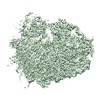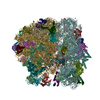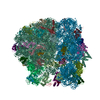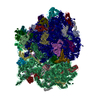[English] 日本語
 Yorodumi
Yorodumi- EMDB-8345: Cryo-EM structure of the human 80S ribosome at 3.6 Angstrom resolution -
+ Open data
Open data
- Basic information
Basic information
| Entry | Database: EMDB / ID: EMD-8345 | |||||||||||||||||||||
|---|---|---|---|---|---|---|---|---|---|---|---|---|---|---|---|---|---|---|---|---|---|---|
| Title | Cryo-EM structure of the human 80S ribosome at 3.6 Angstrom resolution | |||||||||||||||||||||
 Map data Map data | human ribosome | |||||||||||||||||||||
 Sample Sample |
| |||||||||||||||||||||
| Function / homology |  Function and homology information Function and homology informationeukaryotic 80S initiation complex / negative regulation of protein neddylation / response to insecticide / oxidized pyrimidine DNA binding / response to TNF agonist / positive regulation of base-excision repair / negative regulation of endoplasmic reticulum unfolded protein response / negative regulation of peptidyl-serine phosphorylation / regulation of G1 to G0 transition / axial mesoderm development ...eukaryotic 80S initiation complex / negative regulation of protein neddylation / response to insecticide / oxidized pyrimidine DNA binding / response to TNF agonist / positive regulation of base-excision repair / negative regulation of endoplasmic reticulum unfolded protein response / negative regulation of peptidyl-serine phosphorylation / regulation of G1 to G0 transition / axial mesoderm development / negative regulation of formation of translation preinitiation complex / positive regulation of intrinsic apoptotic signaling pathway in response to DNA damage / positive regulation of respiratory burst involved in inflammatory response / ribosomal protein import into nucleus / regulation of translation involved in cellular response to UV / positive regulation of gastrulation / regulation of adenylate cyclase-activating G protein-coupled receptor signaling pathway / protein-DNA complex disassembly / protein tyrosine kinase inhibitor activity / 90S preribosome assembly / IRE1-RACK1-PP2A complex / positive regulation of endodeoxyribonuclease activity / nucleolus organization / positive regulation of Golgi to plasma membrane protein transport / translation at postsynapse / positive regulation of intrinsic apoptotic signaling pathway in response to DNA damage by p53 class mediator / TNFR1-mediated ceramide production / negative regulation of DNA repair / negative regulation of RNA splicing / mammalian oogenesis stage / GAIT complex / A band / positive regulation of DNA damage response, signal transduction by p53 class mediator / supercoiled DNA binding / activation-induced cell death of T cells / TORC2 complex binding / alpha-beta T cell differentiation / NF-kappaB complex / neural crest cell differentiation / G1 to G0 transition / oxidized purine DNA binding / cysteine-type endopeptidase activator activity involved in apoptotic process / positive regulation of ubiquitin-protein transferase activity / negative regulation of intrinsic apoptotic signaling pathway in response to hydrogen peroxide / exit from mitosis / ubiquitin-like protein conjugating enzyme binding / regulation of establishment of cell polarity / translation at presynapse / middle ear morphogenesis / Formation of the ternary complex, and subsequently, the 43S complex / negative regulation of phagocytosis / rRNA modification in the nucleus and cytosol / erythrocyte homeostasis / optic nerve development / cytoplasmic side of rough endoplasmic reticulum membrane / laminin receptor activity / retinal ganglion cell axon guidance / negative regulation of ubiquitin protein ligase activity / protein kinase A binding / ion channel inhibitor activity / Ribosomal scanning and start codon recognition / pigmentation / homeostatic process / response to aldosterone / Translation initiation complex formation / positive regulation of mitochondrial depolarization / positive regulation of T cell receptor signaling pathway / macrophage chemotaxis / fibroblast growth factor binding / negative regulation of Wnt signaling pathway / lung morphogenesis / positive regulation of activated T cell proliferation / male meiosis I / monocyte chemotaxis / negative regulation of translational frameshifting / Protein hydroxylation / BH3 domain binding / TOR signaling / SARS-CoV-1 modulates host translation machinery / regulation of cell division / mTORC1-mediated signalling / T cell proliferation involved in immune response / iron-sulfur cluster binding / Peptide chain elongation / positive regulation of intrinsic apoptotic signaling pathway by p53 class mediator / Selenocysteine synthesis / Formation of a pool of free 40S subunits / endonucleolytic cleavage to generate mature 3'-end of SSU-rRNA from (SSU-rRNA, 5.8S rRNA, LSU-rRNA) / ubiquitin ligase inhibitor activity / Eukaryotic Translation Termination / positive regulation of signal transduction by p53 class mediator / blastocyst development / Response of EIF2AK4 (GCN2) to amino acid deficiency / SRP-dependent cotranslational protein targeting to membrane / negative regulation of ubiquitin-dependent protein catabolic process / cellular response to actinomycin D / Viral mRNA Translation / negative regulation of respiratory burst involved in inflammatory response / Nonsense Mediated Decay (NMD) independent of the Exon Junction Complex (EJC) / protein localization to nucleus Similarity search - Function | |||||||||||||||||||||
| Biological species |  Homo sapiens (human) Homo sapiens (human) | |||||||||||||||||||||
| Method | single particle reconstruction / cryo EM / Resolution: 3.6 Å | |||||||||||||||||||||
 Authors Authors | Zhang X / Lai M / Zhou ZH | |||||||||||||||||||||
| Funding support |  United States, 6 items United States, 6 items
| |||||||||||||||||||||
 Citation Citation |  Journal: Nat Commun / Year: 2016 Journal: Nat Commun / Year: 2016Title: Structures and stabilization of kinetoplastid-specific split rRNAs revealed by comparing leishmanial and human ribosomes. Authors: Xing Zhang / Mason Lai / Winston Chang / Iris Yu / Ke Ding / Jan Mrazek / Hwee L Ng / Otto O Yang / Dmitri A Maslov / Z Hong Zhou /   Abstract: The recent success in ribosome structure determination by cryoEM has opened the door to defining structural differences between ribosomes of pathogenic organisms and humans and to understand ribosome- ...The recent success in ribosome structure determination by cryoEM has opened the door to defining structural differences between ribosomes of pathogenic organisms and humans and to understand ribosome-targeting antibiotics. Here, by direct electron-counting cryoEM, we have determined the structures of the Leishmania donovani and human ribosomes at 2.9 Å and 3.6 Å, respectively. Our structure of the leishmanial ribosome elucidates the organization of the six fragments of its large subunit rRNA (as opposed to a single 28S rRNA in most eukaryotes, including humans) and reveals atomic details of a unique 20 amino acid extension of the uL13 protein that pins down the ends of three of the rRNA fragments. The structure also fashions many large rRNA expansion segments. Direct comparison of our human and leishmanial ribosome structures at the decoding A-site sheds light on how the bacterial ribosome-targeting drug paromomycin selectively inhibits the eukaryotic L. donovani, but not human, ribosome. | |||||||||||||||||||||
| History |
|
- Structure visualization
Structure visualization
| Movie |
 Movie viewer Movie viewer |
|---|---|
| Structure viewer | EM map:  SurfView SurfView Molmil Molmil Jmol/JSmol Jmol/JSmol |
| Supplemental images |
- Downloads & links
Downloads & links
-EMDB archive
| Map data |  emd_8345.map.gz emd_8345.map.gz | 137.1 MB |  EMDB map data format EMDB map data format | |
|---|---|---|---|---|
| Header (meta data) |  emd-8345-v30.xml emd-8345-v30.xml emd-8345.xml emd-8345.xml | 10 KB 10 KB | Display Display |  EMDB header EMDB header |
| Images |  emd_8345.png emd_8345.png | 194.1 KB | ||
| Archive directory |  http://ftp.pdbj.org/pub/emdb/structures/EMD-8345 http://ftp.pdbj.org/pub/emdb/structures/EMD-8345 ftp://ftp.pdbj.org/pub/emdb/structures/EMD-8345 ftp://ftp.pdbj.org/pub/emdb/structures/EMD-8345 | HTTPS FTP |
-Validation report
| Summary document |  emd_8345_validation.pdf.gz emd_8345_validation.pdf.gz | 397.6 KB | Display |  EMDB validaton report EMDB validaton report |
|---|---|---|---|---|
| Full document |  emd_8345_full_validation.pdf.gz emd_8345_full_validation.pdf.gz | 397.3 KB | Display | |
| Data in XML |  emd_8345_validation.xml.gz emd_8345_validation.xml.gz | 6.8 KB | Display | |
| Arichive directory |  https://ftp.pdbj.org/pub/emdb/validation_reports/EMD-8345 https://ftp.pdbj.org/pub/emdb/validation_reports/EMD-8345 ftp://ftp.pdbj.org/pub/emdb/validation_reports/EMD-8345 ftp://ftp.pdbj.org/pub/emdb/validation_reports/EMD-8345 | HTTPS FTP |
-Related structure data
| Related structure data |  5t2cMC  8343C  5t2aC C: citing same article ( M: atomic model generated by this map |
|---|---|
| Similar structure data |
- Links
Links
| EMDB pages |  EMDB (EBI/PDBe) / EMDB (EBI/PDBe) /  EMDataResource EMDataResource |
|---|---|
| Related items in Molecule of the Month |
- Map
Map
| File |  Download / File: emd_8345.map.gz / Format: CCP4 / Size: 163.6 MB / Type: IMAGE STORED AS FLOATING POINT NUMBER (4 BYTES) Download / File: emd_8345.map.gz / Format: CCP4 / Size: 163.6 MB / Type: IMAGE STORED AS FLOATING POINT NUMBER (4 BYTES) | ||||||||||||||||||||||||||||||||||||||||||||||||||||||||||||||||||||
|---|---|---|---|---|---|---|---|---|---|---|---|---|---|---|---|---|---|---|---|---|---|---|---|---|---|---|---|---|---|---|---|---|---|---|---|---|---|---|---|---|---|---|---|---|---|---|---|---|---|---|---|---|---|---|---|---|---|---|---|---|---|---|---|---|---|---|---|---|---|
| Annotation | human ribosome | ||||||||||||||||||||||||||||||||||||||||||||||||||||||||||||||||||||
| Projections & slices | Image control
Images are generated by Spider. | ||||||||||||||||||||||||||||||||||||||||||||||||||||||||||||||||||||
| Voxel size | X=Y=Z: 1.07 Å | ||||||||||||||||||||||||||||||||||||||||||||||||||||||||||||||||||||
| Density |
| ||||||||||||||||||||||||||||||||||||||||||||||||||||||||||||||||||||
| Symmetry | Space group: 1 | ||||||||||||||||||||||||||||||||||||||||||||||||||||||||||||||||||||
| Details | EMDB XML:
CCP4 map header:
| ||||||||||||||||||||||||||||||||||||||||||||||||||||||||||||||||||||
-Supplemental data
- Sample components
Sample components
-Entire : Human ribosome (Jurkat)
| Entire | Name: Human ribosome (Jurkat) |
|---|---|
| Components |
|
-Supramolecule #1: Human ribosome (Jurkat)
| Supramolecule | Name: Human ribosome (Jurkat) / type: complex / ID: 1 / Parent: 0 |
|---|---|
| Source (natural) | Organism:  Homo sapiens (human) / Cell: Jurkat Homo sapiens (human) / Cell: Jurkat |
-Experimental details
-Structure determination
| Method | cryo EM |
|---|---|
 Processing Processing | single particle reconstruction |
| Aggregation state | particle |
- Sample preparation
Sample preparation
| Buffer | pH: 7.6 |
|---|---|
| Vitrification | Cryogen name: ETHANE / Chamber humidity: 100 % |
- Electron microscopy
Electron microscopy
| Microscope | FEI TITAN KRIOS |
|---|---|
| Image recording | Film or detector model: GATAN K2 SUMMIT (4k x 4k) / Detector mode: COUNTING / Average electron dose: 25.0 e/Å2 |
| Electron beam | Acceleration voltage: 300 kV / Electron source:  FIELD EMISSION GUN FIELD EMISSION GUN |
| Electron optics | Illumination mode: FLOOD BEAM / Imaging mode: BRIGHT FIELD |
| Experimental equipment |  Model: Titan Krios / Image courtesy: FEI Company |
 Movie
Movie Controller
Controller














































 Z (Sec.)
Z (Sec.) Y (Row.)
Y (Row.) X (Col.)
X (Col.)






















